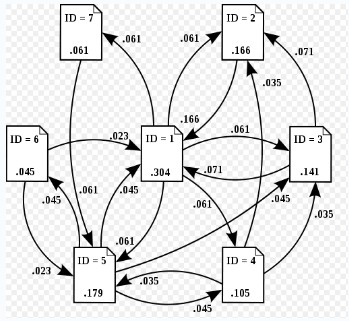Again, assume there are four web pages: A, B, C and D.
Each document begins with an estimated PageRank of 0.25.
If pages B, C, and D each only link to A, they would each confer 0.25 PageRank to A.
All PageRank PR( ) in this simplistic system would thus gather to A because all links would be pointing to A.
PR(A) = PR(B) + PR(C) + PR(D) |

|
This is 0.75. Again, suppose page
B also has a link to page C, and page D has links to all three pages.
The value of the link-votes is divided among all the outbound links on a page.
Thus, page B gives a vote worth 0.125 to page A and a vote worth 0.125 to page C.
Only one third of D’s PageRank is counted for A’s PageRank (approximately 0.083).
PR(A) = {PR(B)/2} + {PR(C)/1} + {PR(D)/3}
In other words, the PageRank conferred by an outbound link is equal to the document’s own PageRank score divided by the normalized number of outbound links L( ) (assume that links to specific URLs only count once per document).
PR(A) = {PR(B)/L(B)} + {PR(C)/L(C)} + {PR(D)/L(D)}
In the general case, the PageRank value for any page u can be expressed as:
PR(u) = Σ{PR(v)/L(v)}, where v∈Bu
i.e. the PageRank value for a page u is dependent on the PageRank values for each page v out of the set Bu (this set contains all pages linking to page u), divided by the number L(v) of links from page v.
|
Nine times out of ten (almost always) your first choice turns out to be the right one. |